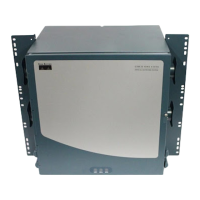19-63
Cisco ONS 15454 Procedure Guide, R5.0
September 2005
Chapter 19 DLPs A200 to A299
DLP-A298 Check the Network for Alarms and Conditions
Step 7 Return to your originating procedure (NTP).
DLP-A298 Check the Network for Alarms and Conditions
Step 1 From the View menu, choose Go to Network View. Verify that all affected spans on the network map
are green.
Step 2 Verify that the affected spans do not have active switches on the network map. Span ring switches are
represented by the letters “L” for lockout ring, “F” for Force ring, “M” for Manual ring, and “E” for
Exercise ring.
Step 3 A second verification method can be performed from the Conditions tab. Click Retrieve Conditions and
verify that no switches are active. Make sure the Filter button is not selected.
Step 4 Click the Alarms tab.
a. Verify that the alarm filter is not on. See the “DLP-A227 Disable Alarm Filtering” task on
page 19-17 as necessary.
b. Verify that no unexplained alarms appear on the network. If alarms appear, investigate and resolve
them before continuing. Refer to the Cisco ONS 15454 Troubleshooting Guide for procedures.
Step 5 Return to your originating procedure (NTP).
DLP-A299 Initiate a BLSR Span Lock Out
Caution Traffic is not protected during a span lockout.
Step 1 Click the Provisioning > BLSR tabs.
Purpose This task verifies that no alarms or conditions exist on the network.
Tools/Equipment None
Prerequisite Procedures DLP-A60 Log into CTC, page 17-66
Required/As Needed As needed
Onsite/Remote Onsite or remote
Security Level Retrieve or higher
Purpose This task allows you to perform a BLSR span lockout, which prevents
traffic from switching to the locked out span.
Tools/Equipment None
Prerequisite Procedures DLP-A60 Log into CTC, page 17-66
Required/As Needed As needed
Onsite/Remote Onsite or remote
Security Level Provisioning or higher

